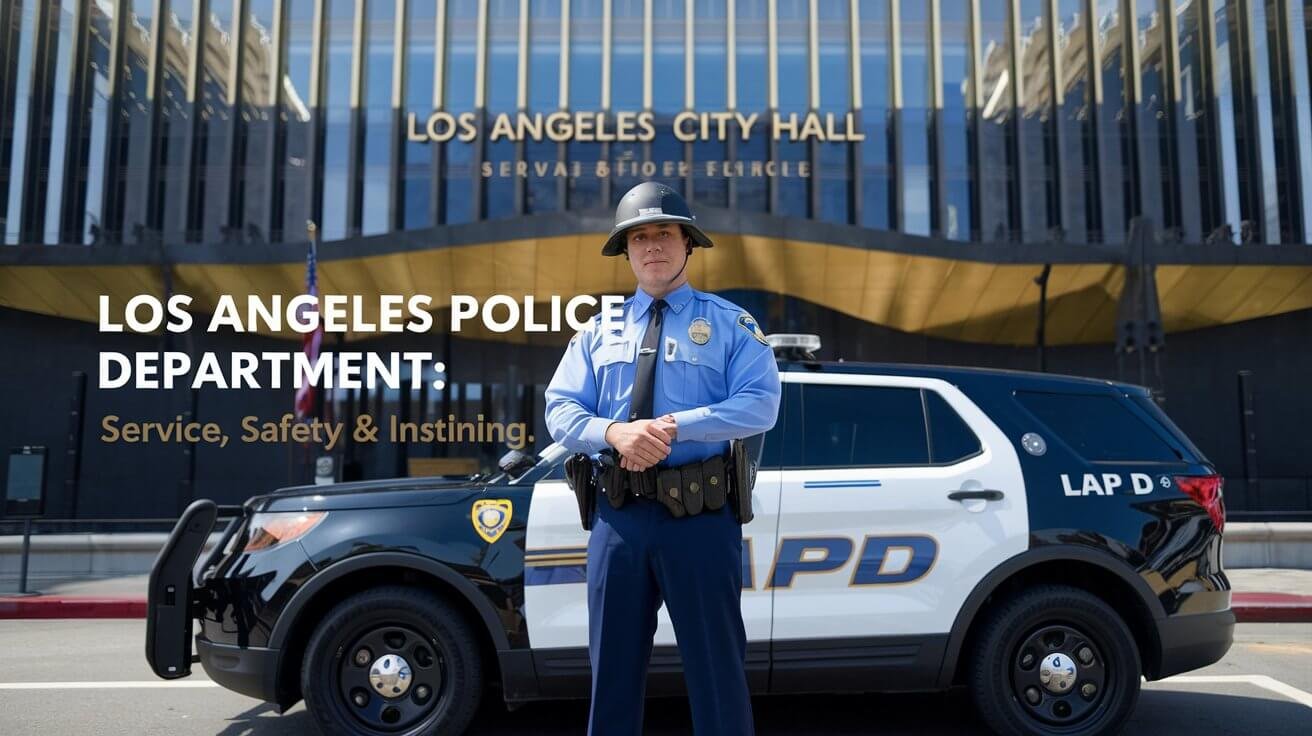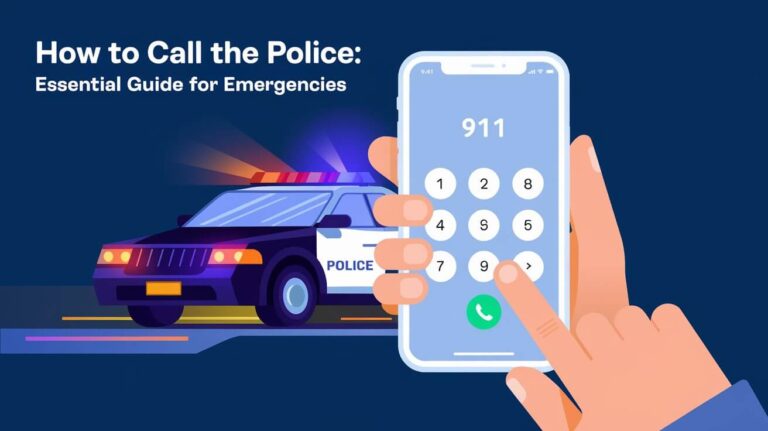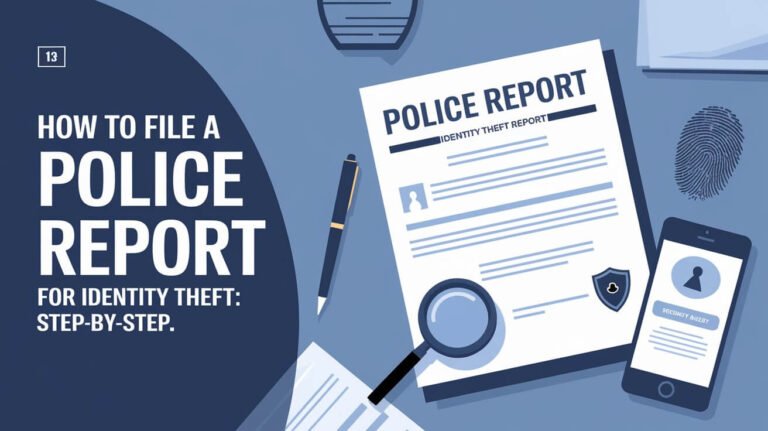Los Angeles Police Department: Service, Safety & Integrity

The Los Angeles Police Department, or LAPD, is the main law enforcement for Los Angeles, California. It serves nearly four million people. The LAPD has a long history, starting in 1869.
Today, it has over 8,000 sworn officers and 3,000 civilians. This makes it one of the biggest law enforcement agencies in the U.S. It plays a key role in keeping Los Angeles safe.
LAPD has changed a lot over time. It has grown to meet the community’s needs. Now, it’s a top example of effective law enforcement in the U.S.
Because of this, the LAPD is well-known and respected. It’s dedicated to serving the community well. It ensures the safety and well-being of Los Angeles residents.
Origins of the Los Angeles Police Department
The Los Angeles Police Department (LAPD) started in 1869 with six officers. This was a big change from volunteer police to a paid force. The LAPD’s history shows how the city grew and needed a professional police force.
Over time, the LAPD has changed to fit the city’s needs. Highlights include starting the first SWAT team in 1965 and using community policing. These steps helped the LAPD protect and serve the community better.
Establishment in 1869
In 1869, the first police force had six officers. As Los Angeles grew, so did the police department. By 1903, the department had 200 officers thanks to the Civil Service system.
Evolution Through the Decades
The LAPD has grown a lot over the years. It started the Gangster Squad in 1946 and the SWAT unit in 1965. The LAPD has always looked for new ways to fight crime and stay up-to-date with technology.
Milestone Achievements
The LAPD has made many important achievements. For example, it recovered over $121 million in stolen art by 1993. The department has also focused on community policing to build trust. These efforts have helped the LAPD protect and serve the community well.
LAPD Service Districts
The Los Angeles Police Department is split into different service districts. Each one serves a unique community. Officers get to know the specific needs and challenges of their area. This helps them work better with the community to prevent crime and improve life.
The LAPD has 21 community police stations, like 77th Street and Central. Each area is set up to meet the needs of its neighborhood. This shows the LAPD’s effort to understand and serve the diverse people of Los Angeles. They also have 21 Community-Police Advisory Boards (C-PABs) to get feedback from the community.
- Central Bureau: 5 Community Police Stations
- South Bureau: 5 Community Police Stations
- West Bureau: 6 Community Police Stations
- Valley Bureau: 7 Community Police Stations
The LAPD’s service districts aim to provide good policing and community service. By dividing the city, they can tackle each community’s unique issues. This helps make the city safer and better for everyone.
| Bureau | Number of Community Police Stations |
|---|---|
| Central Bureau | 5 |
| South Bureau | 5 |
| West Bureau | 6 |
| Valley Bureau | 7 |
Police Training Academy Programs
Los Angeles Police Department (LAPD) academy offers top-notch training to new recruits. It focuses on police training that gives officers the skills and knowledge they need. The LAPD academy is known for its tough and detailed programs.
The recruitment process is very competitive. Candidates go through background checks, physical tests, and academic assessments. Once chosen, recruits start a six-month training that includes physical and academic parts. They learn about law, ethics, and community policing strategies at the LAPD academy.
Some key parts of the training include:
- Physical fitness training, which includes building strength and endurance through conditioning
- Self-defense training, which is a big part of the academy’s curriculum
- Academic training, which covers topics such as law, human relations, and report writing
LAPD academy gives officers a well-rounded education. It prepares them for the challenges of police work. This makes it a top example of police training.
Crime Prevention Initiatives
Los Angeles Police Department has launched many crime prevention efforts. These include neighborhood watch programs and community outreach. These programs help reduce crime and make communities safer.
Some key strategies include:
- Installing locks, safes, and alarm systems to boost business security
- Teaching all employees, including maintenance staff, about security procedures
- Using video monitoring services, like Stealth Monitoring, to cut down on security guard costs
Teaming up with local groups and businesses, the LAPD can stop crime and keep communities safe. The department’s hard work is shown in the drop in murder rates. From over 1,000 in the early 1990s to 382 in 2022, the numbers have fallen significantly.
| Year | Murder Count |
|---|---|
| 1990s | over 1,000 |
| 2013 | 251 |
| 2021 | 397 |
| 2022 | 382 |
Community Outreach Programs
The Los Angeles Police Department (LAPD) knows how important community engagement is. They work hard to build trust and cooperation between law enforcement and the community. Their programs aim to help residents and support those in need.
Some of the key community outreach programs include:
- Youth development projects, such as the Explorers program, which offers training for a career in law enforcement and community service opportunities for individuals aged 14 to 21.
- Neighborhood Watch coordination, where local residents actively participate in crime reduction initiatives across various neighborhoods citywide.
- Public safety education, with the LAPD providing workshops and materials on topics such as crime prevention, emergency preparedness, and traffic safety.
LAPD also operates 18 Community Police Advisory Boards (C-PABs), where volunteers advise Area commanding officers on crime and quality of life issues. The Senior Lead Officer (SLO) program is another key effort. It connects the LAPD with the community to tackle local problems. Together, they work to make the community safer and more supportive for everyone.
Special Units and Task Forces
The Los Angeles Police Department (LAPD) has many special units and task forces. Each one is made to tackle specific law enforcement challenges. These units show the LAPD’s strong commitment to working together and keeping the community safe.
The LAPD has some notable special units, like the SWAT team, K-9 unit, and Metropolitan Division. The LAPD Air Support Division is the biggest in the world. It operates from the nation’s largest rooftop heliport. Here are some key facts about the LAPD’s special units:
- The SWAT team has safely rescued hostages and arrested many violent suspects. This started in 1967.
- The K-9 Platoon is ready 24/7 to help find dangerous felons, armed suspects, and lost people.
- The Off Road Detail patrols 221.8 miles of rough terrain in the San Fernando Valley.
These LAPD special units and task forces team up to fight issues like human trafficking, cybercrime, and terrorism. They show the department’s strong commitment to protecting the community.
| Unit | Description |
|---|---|
| LAPD Air Support Division | Largest municipal airborne law enforcement operation in the world |
| SWAT Team | High-risk situation response and hostage rescue |
| K-9 Platoon | Searches for dangerous felons, armed suspects, and lost individuals |
Emergency Response Protocols
The Los Angeles Police Department (LAPD) has set up emergency response plans. These plans help the LAPD respond quickly and effectively to urgent situations. They aim to protect people and property from harm.
The LAPD’s dispatch system runs 24/7, using advanced technology to send help fast. This system ensures the LAPD can quickly answer emergency calls. The LAPD also has plans for handling big incidents like hostage situations and mass casualties.
Some key parts of the LAPD’s emergency response plans include:
- Dispatch system operations: The LAPD’s dispatch system is designed to quickly and efficiently dispatch units to emergency situations.
- Critical incident management: The LAPD has protocols in place for managing critical incidents, including hostage situations and mass casualty incidents.
- Disaster preparedness: The LAPD works closely with other emergency services to ensure a coordinated response to disasters and large-scale emergencies.
The LAPD’s emergency response plans are key to keeping the public safe. By acting fast and working together, the LAPD reduces the risk of harm. This helps keep the community safe.
| Emergency Response Statistic | Value |
|---|---|
| CERT Program start month and year | June 1986 |
| Average number of CERT Basic Training Courses conducted per year | 70 |
| Total number of CERT classes that have graduated | 970 |
Technology and Innovation
Los Angeles Police Department (LAPD) is leading the way in using technology to improve policing. They have moved from old, heavy laptops to new, mobile devices for all officers. This change focuses on making officers more mobile.
The LAPD wants to make its mobile strategy even stronger. They plan to use artificial intelligence to cut down on paperwork. This will let officers spend more time with the community. The LAPD is using several technologies, including:
- Cloud computing
- Mobile integration
- Cybersecurity
- Video analytics
- Automated License Plate Recognition (ALPR)
LAPD is also using advanced crime analytics tools. They measure how well these tools work by looking at arrests and crime rates. The department is growing its use of FirstNet, a network made for first responders. This will help improve communication and teamwork.
| Technology | Description |
|---|---|
| FirstNet | A nationwide communications platform for emergency responses across agencies and jurisdictions |
| ALPR | Sensors that capture license plate data for real-time interventions, sending notifications directly to officers’ devices |
| Cloud Computing | Enables the LAPD to store and process large amounts of data, improving efficiency and reducing costs |
Public Safety Resources
The Los Angeles Police Department (LAPD) is dedicated to keeping the community safe. They offer many resources to help everyone stay safe. You can find tools, crime stats, and safety tips on their website.
Some important resources from the LAPD include:
- Online reporting tools, so you can report non-emergency crimes from home
- A crime statistics portal with info on crime trends and rates in different areas
- Safety guidelines and tips on home security, personal safety, and being ready for emergencies
The LAPD’s online tools are key to their public safety efforts. They make it easy for people to get the info they need. By using these tools, you help the LAPD serve the community better.
| Resource | Description |
|---|---|
| Online Reporting Tools | Let you report non-emergency crimes and incidents online |
| Crime Statistics Portal | Shows crime trends and rates in different neighborhoods |
| Safety Guidelines and Tips | Give advice on home security, personal safety, and emergency readiness |
The LAPD is working hard to make our community safer and more informed. Their commitment to being open and accessible is shown in their online tools. These resources help everyone play a part in keeping our community safe.
Partnership With Local Organizations
The Los Angeles Police Department knows how key LAPD partnerships are. They work with many groups like community organizations, schools, and churches. This helps them fight crime and build trust in the community.
A meeting at the Hollywood Armenian Community Center showed how important these partnerships are. It happened on February 3, 2025. People from all walks of life came together to talk about safety and hate crimes. They stressed the need for working together to keep everyone safe.
Some of the LAPD’s efforts include:
- Community Safety Partnership Bureau (CSP), started in 2018 to improve community ties
- Working with groups like the Armenian National Committee to tackle community issues
- Reaching out to Armenian-American communities to build stronger bonds
Studies show the LAPD’s partnerships are making a difference. A UCLA study in March 2020 found that people feel safer. The CSP has also cut down on crime and gang violence in some areas. It has also made residents more trusting of the police.
Final Outcome
The Los Angeles Police Department (LAPD) is deeply committed to protecting the city’s diverse community. It has a rich history and offers many specialized units. The LAPD also runs innovative outreach programs to build strong bonds with the people it serves.
The LAPD faces many challenges but stays true to its mission. It aims to keep the city safe with integrity, compassion, and professionalism. The department keeps improving through training, technology, and transparency, making Los Angeles safer and more vibrant.
The LAPD’s dedication to the community will always be its guiding force. It ensures the department’s legacy of service and excellence will last for many years. With a strong foundation and spirit, the LAPD is a model of law enforcement excellence, ready to protect the City of Angels.
Common Queries
What is the Los Angeles Police Department (LAPD)?
The Los Angeles Police Department (LAPD) is a big and well-known law enforcement agency in the U.S. It started in 1869 and has grown a lot over the years. It now serves the community in new and better ways.
How has the LAPD grown and developed over time?
The LAPD began with just six officers. Now, it has over 8,000 sworn officers and 3,000 civilian staff. It has made big strides, like starting the first SWAT team in 1965 and using community policing.
How is the LAPD structured to serve the community?
The LAPD is split into service districts with their own police stations. This setup helps officers get to know their areas well. They work closely with the community to prevent crime and improve life.
What kind of training and recruitment process do LAPD officers undergo?
The LAPD’s Police Training Academy is known for its tough programs. Officers learn a lot and get in shape. The recruitment is tough, with lots of checks and tests.
What crime prevention initiatives does the LAPD implement?
The LAPD fights crime with proactive steps and community help. It has neighborhood watch programs and outreach for kids and gangs.
How does the LAPD engage with the community?
The LAPD works hard to build trust and safety. It has programs for kids, like after-school activities and mentorship. It also helps with neighborhood watches and teaches about safety.
What specialized units and task forces does the LAPD have?
LAPD has many special units, like SWAT and K-9. It also works with other agencies on big issues like human trafficking and cybercrime.
How does the LAPD respond to emergencies and critical incidents?
The LAPD has quick and effective emergency plans. It has a 24/7 dispatch and works with other services for big incidents.
How does the LAPD utilize technology and innovation?
The LAPD uses the latest tech to improve policing. It has body-worn cameras, drones, and digital tools for the community.
What public safety resources does the LAPD offer?
LAPD provides many safety resources online. You can report crimes, check crime stats, and get safety tips on its website and social media.
How does the LAPD collaborate with local organizations?
The LAPD works with many local groups to keep the community safe. It partners with schools, businesses, and faith groups to fight crime and engage the community.






